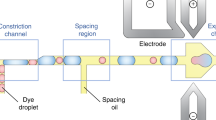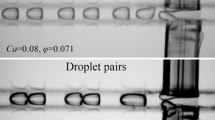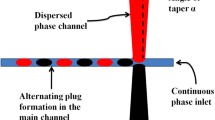Abstract
We demonstrate a simple approach for merging droplets in an on-demand, parallel manner via non-contact pairing of two droplets. The non-contact pairing can be achieved by exploiting flow-induced deformability of a droplet with a unique structure of merging element. Non-contact paired droplets, which are initially stabilized by surfactant molecules, can be merged simply by destabilizing the droplet interface and bringing two droplets into contact. On-demand, parallel droplet merging is performed with a proper pressure profile achieved by a pneumatic pressure supply system, and merging process is solely dependent on the pressure-driven fluid flow. We achieved an average merging efficiency of 90.0 % (SD = 3.14, n = 450) in performing parallel merging in a non-contact paired droplet array. We also evaluated the on-demand merging performance by measuring the average merging delay time (mean = 3.25 s, SD ± 1.09 s, n ~ 180). Furthermore, we demonstrated the applicability of our device for the initiation of a chemical reaction through the merging of two droplets with different chemical contents. We believe that the proposed method will be useful for studying various droplet-based reactions.







Similar content being viewed by others
References
Anna SL, Bontoux N, Stone HA (2003) Formation of dispersions using “flow focusing” in microchannels. Appl Phys Lett 82:364–366
Baret J-C (2012) Surfactants in droplet-based microfluidics. Lab Chip 12:422–433
Baroud et al (2010) Dynamics of microfluidic droplets. Lab Chip 10:2032–2045
Bremond N, Thiam AR, Bibette J (2008) Decompressing emulsion droplets favors coalescence. Phys Rev Lett 100:024501
Brouzes E et al (2009) Droplet microfluidic technology for single-cell high-throughput screening. Proc Natl Acad Sci 106:14195–14200
Cho S et al (2013) Droplet-based microfluidic platform for high-throughput, multi-parameter screening of photosensitizer activity. Anal Chem 85:8866–8872
Dendukuri D, Doyle PS (2009) The synthesis and assembly of polymeric microparticles using microfluidics. Adv Mater 21:4071–4086
Dura B, Liu Y, Voldman J (2014) Deformability-based microfluidic cell pairing and fusion. Lab Chip 14:2783–2790
Fradet E, Mcdougall C, Abbyad P, Dangla R, Mcgloin D, Baroud CN (2011) Combining rails and anchors with laser forcing for selective manipulation within 2D droplet arrays. Lab Chip 11:4228–4234
Fuerstman MJ, Lai A, Thurlow ME, Shevkoplyas SS, Stone HA, Whitesides GM (2007) The pressure drop along rectangular microchannels containing bubbles. Lab Chip 7:1479–1489
Guo MT, Rotem A, Heyman JA, Weitz DA (2012) Droplet microfluidics for high-throughput biological assays. Lab Chip 12:2146–2155
Han Z, Li W, Huang Y, Zheng B (2009) Measuring rapid enzymatic kinetics by electrochemical method in droplet-based microfluidic devices with pneumatic valves. Anal Chem 81:5840–5845
Joensson HN, Andersson Svahn H (2012) Droplet microfluidics—a tool for single-cell analysis. Angew Chem Int Ed 51:12176–12192
King PH, Jones G, Morgan H, de Planque MRR, Zauner K-P (2014) Interdroplet bilayer arrays in millifluidic droplet traps from 3D-printed moulds. Lab Chip 14:722–729
Lee B, Yoo JY (2011) Droplet bistability and its application to droplet control. Microfluid Nanofluidics 11:685–693
Leshansky A, Pismen L (2009) Breakup of drops in a microfluidic T junction. Physics of Fluids 21:023303 (1994-present)
Link D, Anna SL, Weitz D, Stone H (2004) Geometrically mediated breakup of drops in microfluidic devices. Phys Rev Lett 92:054503
Mazutis L, Griffiths AD (2009) Preparation of monodisperse emulsions by hydrodynamic size fractionation. Appl Phys Lett 95:204103
Mazutis L, Gilbert J, Ung WL, Weitz DA, Griffiths AD, Heyman JA (2013) Single-cell analysis and sorting using droplet-based microfluidics. Nat Protoc 8:870–891
Niu X, Gulati S, Edel JB (2008) Pillar-induced droplet merging in microfluidic circuits. Lab Chip 8:1837–1841
Priest C, Herminghaus S, Seemann R (2006) Controlled electrocoalescence in microfluidics: targeting a single lamella. Appl Phys Lett 89:134101
Schaerli Y, Hollfelder F (2009) The potential of microfluidic water-in-oil droplets in experimental biology. Mol BioSyst 5:1392–1404
Sesen M, Alan T, Neild A (2014) Microfluidic on-demand droplet merging using surface acoustic waves. Lab Chip
Simon MG, Lin R, Fisher JS, Lee AP (2012) A Laplace pressure based microfluidic trap for passive droplet trapping and controlled release. Biomicrofluidics 6:014110
Song H, Bringer MR, Tice JD, Gerdts CJ, Ismagilov RF (2003) Experimental test of scaling of mixing by chaotic advection in droplets moving through microfluidic channels. Appl Phys Lett 83:4664–4666
Song H, Chen DL, Ismagilov RF (2006) Reactions in droplets in microfluidic channels. Angew Chem Int Ed 45:7336–7356
Srisa-Art M, Dyson EC, deMello AJ, Edel JB (2008) Monitoring of real-time streptavidin—biotin binding kinetics using droplet microfluidics. Anal Chem 80:7063–7067
Tan Y-C, Ho YL, Lee AP (2007) Droplet coalescence by geometrically mediated flow in microfluidic channels. Microfluid Nanofluidics 3:495–499
Thorsen T, Roberts RW, Arnold FH, Quake SR (2001) Dynamic pattern formation in a vesicle-generating microfluidic device. Phys Rev Lett 86:4163
Tullis J, Park CL, Abbyad P (2014) Selective fusion of anchored droplets via changes in surfactant concentration. Lab Chip 14:3285–3289
Tung K-Y, Li C-C, Yang J-T (2009) Mixing and hydrodynamic analysis of a droplet in a planar serpentine micromixer. Microfluid Nanofluidics 7:545–557
Um E, Rha E, Choi S-L, Lee S-G, Park J-K (2012) Mesh-integrated microdroplet array for simultaneous merging and storage of single-cell droplets. Lab Chip 12:1594–1597
Xia Y, Whitesides GM (1998) Soft lithography. Annu Rev Mater Sci 28:153–184
Acknowledgments
This research was supported by BioNano Health-Guard Research Center funded by the Ministry of Science, ICT & Future Planning (MSIP) of Korea as Global Frontier Project (H-GUARD_2014M3A6B2060526) and Basic Research Program through the National Research Foundation of Korea (NRF) funded by the Ministry of Education, Science and Technology (2012R1A1A2006305), and a grant of the Korea Health Technology R&D Project through the Korea Health Industry Development Institute (KHIDI), funded by the Ministry of Health & Welfare, Republic of Korea (Grant Number: HI15C0001).
Author information
Authors and Affiliations
Corresponding author
Electronic supplementary material
Below is the link to the electronic supplementary material.
10404_2015_1676_MOESM1_ESM.docx
Characterization of the effect of the front neck width and droplet diameter on required suction pressure to droplet trap or squeeze, design of a droplet generation device, experimental setup (DOCX 6789 kb)
Droplet merging behavior under two pairing modes (WMV 1369 kb)
Rights and permissions
About this article
Cite this article
Lee, S., Kim, H., Won, DJ. et al. On-demand, parallel droplet merging method with non-contact droplet pairing in droplet-based microfluidics. Microfluid Nanofluid 20, 1 (2016). https://doi.org/10.1007/s10404-015-1676-z
Received:
Accepted:
Published:
DOI: https://doi.org/10.1007/s10404-015-1676-z




